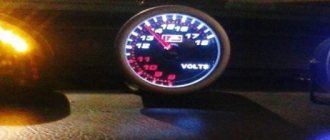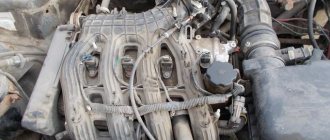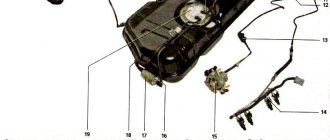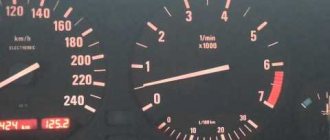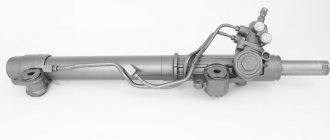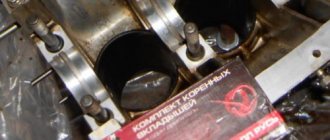Checking oil pressure
Recommendation
If, when the engine is warmed up to operating temperature and idling, the emergency oil pressure lamp lights up, you should make sure that:
a) the oil level in the engine sump is normal;
b) the engine is filled with oil in accordance with the factory operating instructions;
c) the oil pressure sensor is working and its wire is not shorted to ground. The integrity of the sensor wire insulation is checked visually. To check the sensor itself, replace it with a known good one and start the engine. If the control lamp continues to light, it means that the sensor is working;
d) there are no extraneous sounds coming from the engine (knocks, grinding noises) indicating cranking of the connecting rod or main bearings or a malfunction of the oil pump.
To complete the work you will need a pressure gauge.
Execution Sequence
1. We prepare the car for work.
2. Start the engine and warm it up to operating temperature.
3. After turning off the engine, remove the emergency oil pressure sensor.
4. Screw the tip of the pressure gauge into the mounting hole of the sensor.
5. Start the engine and check the oil pressure at idle speed at a crankshaft speed of about 5,400 min-1.
Comment
For a serviceable engine warmed up to operating temperature, the oil pressure at idle speed should be at least 196.2 kPa (2 bar), and the oil pressure at high crankshaft speed should be 441.3-637.4 kPa (4.5-6 .5 bar). If the pressure is below normal, then the engine needs major repairs. If the oil pressure is higher than normal at high engine speeds, the oil pump relief valve is probably faulty.
6. Upon completion of the test, install the sensor in place
Add a comment Cancel reply
You must be logged in to post a comment.
Diagnostics of DDM on Lada Priora
Controllers for Priora cannot be repaired, since the main failure of the part will be rupture of the membrane or oxidation of the contacts of the closing group. The cost of a spare part is in the range of 100–200 rubles, so it is more advisable to replace the part. Sensor diagnostics are carried out in two ways:
- pressure gauge;
- mechanically.
Checking with a pressure gauge is a more accurate method of diagnosis; you need to unscrew the sensor with a 21 head and install a pressure meter in its place. If the device readings are below 0.65 kg/cm², this means that the pressure in the lubrication system is insufficient, the indicator lamp should light up, the sensor is faulty.
The mechanical method is used if there is no pressure gauge at hand. It is necessary to remove the controller from the lubrication system, do not start the engine, and crank the starter several times. If oil appears from the socket, the sensor needs to be replaced.
Engine oil pressure. Which should it be? We will also analyze the 16 valve engine from the VAZ 2112
Nowadays, fewer and fewer cars are equipped with an engine oil pressure sensor, if you look at budget foreign cars - I don’t even remember which ones have it. However, now there are enough cars of previous generations on the market, but they had such a sensor. For example, on some VAZ, UAZ, VOLGA, etc. Many people ask the question - what oil pressure should be in the engine, that is, what is the normal value and what is not? It is not always possible to find information specifically about your model, so this article will be useful to everyone...
THE CONTENT OF THE ARTICLE
You know, now manufacturers are simplifying the dashboard of cars more and more, for example, on mine ( Chevrolet Aveo T300 ) there is no longer even an engine temperature sensor, I’m already silent about the oil pressure sensor. It turns out that the manufacturers want YOU to ruin your iron horse faster, because you cannot control all the necessary parameters, and accordingly, if you operate it incorrectly, you will quickly come running to them to repair it. All this can be attributed to a conspiracy by the manufacturers. Although now they say everywhere that cars have become more reliable, different materials are used, etc., but practice shows the opposite, three to five years and it’s better to change the car. Oh, there were times - there were cars, there was complete control over the engine.
Why do you need oil at all?
I often hear that oil is the lifeblood of the engine. This is not entirely true, of course, the comparison is very rough, but still, the engine will not function without oil (or it will, but not for a very long time).
Modern motor oils lubricate and protect all rubbing parts, and these are pistons (with their rings), shafts, bearings, etc. Let's just say that good oil extends the life of the engine by many thousands of kilometers.
BUT oil must flow through the system, just like blood itself through human vessels, if the oil is simply poured in a pan and does not go to the rubbing parts - IT IS USELESS!
Why do you need an oil pump pressure reducing valve?
As you know, oil is supplied to moving engine parts under a certain pressure created by a running pump. Without this, the lubricant would simply flow into the crankcase, exposing the elements of the crank and gas distribution mechanisms to increased friction and overheating. But too high a pressure is also dangerous for the engine. Gaskets, seals, seals are not able to withstand exceeding its normal values. Because of this, oil begins to ooze from under them, and can also enter the power and cooling system of the power unit.
What builds up oil pressure in the system?
Everything is simple here - there is a special oil pump that takes oil from the engine sump and pumps it through the system. It is usually installed in the engine sump and driven by special gears that the engine turns during operation.
Oil through many channels begins to be supplied to the right places under pressure, as I already wrote, this is the crankshaft and its bearings, the camshaft and its “bed”, pistons, and much more.
It is the pump that is responsible for the pressure; if the pump stops, the pressure indicator will drop to zero. THIS CANNOT BE ALLOWED! Because the engine will not be lubricated at all, which will lead to instant breakdown, especially at high speeds.
BUT often the oil pump does not stop, but simply begins to pump worse, this indicates its wear, which is why you need to know the oil pressure in the engine! To respond in time to the nearest oil pump failure.
Causes
The oil pressure warning light comes on when the engine is warm
If we are talking about oil pressure, then naturally the problem is in the engine, namely in some components and parts. To determine the causes, it is necessary to know the structure and operation of the power unit, since without this it will be impossible to eliminate malfunctions. So, let’s look at the reasons why such a warning light may appear on the instrument panel:
- There is a malfunction in the sensor and wiring.
- The oil level has dropped below normal (see “how to check the oil level”).
- Signal to change the oil.
- The oil pump has failed.
- The malfunction is hidden in the cylinder head or directly in the cylinder block itself.
When all the reasons have been considered, it is necessary to move on to a consistent definition of the problem and options for eliminating it.
Solution methods
In order to eliminate an engine malfunction, you will need a set of tools, as well as knowledge of the structure of a car engine. So, let's look at how to fix the problem.
Sensor and wiring
Before you start panicking, you need to turn to the most harmless solution - a sensor. If it fails, the contacts close, so the lamp on the instrument panel can remain on constantly. To solve the problem, it is necessary to dismantle the sensor itself and check it, replacing it if necessary.
Removing the oil pressure sensor wire connector
If replacing the sensor did not yield anything, then you should check the wiring for insulation and continuity. Maybe a wire broke somewhere and that was causing the problem. Using a multimeter, it is worth diagnosing the wiring, which will take a few minutes. If a break is detected, in order not to go to extremes, it is necessary to clean the break site and solder the wiring, then insulate it from external factors. This can be done using a crimp tube or electrical tape.
Insufficient oil level
Insufficient oil level in the power unit can also cause the indicator to appear. This is due to the fact that with a small amount of lubricating fluid, the pressure in the engine itself also drops, and therefore the sensor transmits a signal to the ECU that the compression is not enough. To eliminate the malfunction, it is necessary to add oil to the engine until the level is between the maximum and minimum marks.
A dipstick that shows how much oil is in the engine
Change of oil
Another reason why the oil pressure indicator on the dashboard starts to light is the production of lubricating fluid. Thus, the loss of physicochemical and technical qualities can cause the pressure to drop to a minimum and lead to a signal. The way to solve the problem is to simply replace the lubricant and, accordingly, the filter, which, most likely, is also not in the best condition.
The oil filler neck is unscrewed to fill the liquid
Oil pump
More complex reasons and solutions for the appearance of an oil pressure indicator is the failure of the oil pump.
A pump malfunction makes it impossible for oil to circulate through the system, and therefore it is not possible to create the required pressure. So, its replacement will require disassembling and repairing half of the power unit, and therefore, as practice shows, motorists carry out major repairs of the internal combustion engine.
Oil pump removal diagram
Block head and power unit
The last reason that can catastrophically affect the loss of pressure in the main power unit is the malfunction of this unit. Thus, small gaps in the gaskets and regular loss of oil reduce the pressure, which in turn leads to increased wear of the entire assembly. Another reason for the drop in pressure in the engine and the activation of the indicator can be the wear and tear of the connecting rod and piston group, crankshaft and camshaft, as well as oil seals.
Source
Alarm indication
Of course, now in almost all cars there is an emergency indication for a complete lack of pressure, this is known to us all - a “burning oil can”. If it doesn’t go out for some time after starting, for example 10 – 20 seconds is one thing, it’s almost always the oil filter’s fault . But if the lamp is constantly on, then this is already an alarm bell. Perhaps the oil pressure sensor has simply failed, or perhaps the oil pump has failed.
In any case, the emergency indication is very important, and I do not advise you to joke with it; nevertheless, this is fraught with a major engine overhaul .
Remember this rule, if the lamp comes on, then turn off the car and preferably immediately to a service station, either a tow truck, or in tow.
Instructions for replacing DDM
For safety reasons, replacement work should be carried out with the engine cooled down and wearing cloth gloves. From the tools you should prepare a key for “21”.
The procedure consists of a sequence of steps:
- First, the minus terminal from the battery is disconnected.
- For convenience, remove the air filter.
- The DDM and around it should be wiped with a rag to prevent dirt from getting inside.
- By pressing the wire block, disconnect it from the regulator.
- Using a key, loosen the sensor and unscrew it from the socket.
- We install a new device. In this case, a metal O-ring should also be installed.
- Assembly is performed in the reverse order of removal.
What value should it be?
To begin with, it is worth noting that pressure is measured in bars (BAR), because we are measuring liquid. It’s unlikely that anyone will tell you the exact values now, because the structures of the engines are different, but there is a certain normal interval.
AT idle speed it is 2 BAR (or 0.2 MPa), for most cars
At 4000 - 5000 rpm - this is 4.5 - 6.5 BAR (0.45 - 0.65 MPa), also for most brands
If we take our VAZ 2112 16 valve version, then the pressure at idle is slightly higher, about 1.5 - 2.5 BAR. But at 4000 - 5000 rpm 0.4 - 0.6 BAR.
Actually, I’ll end here, I think the information was useful, read our AUTOBLOG.
(
6 votes, average: 2.50 out of 5)
Similar news
Why do you close the radiator in winter? Let's say with cardboard, the necessary knowledge
Mileage 100,000-150,000 km. Is it a lot or a little, what needs to be changed? Ra.
OTTO cycle. ATKINSON. MILLER. What is it, what are the differences in ra.
Add a comment Cancel reply
Comments
TOP articles for the month
The holidays are coming, which means most of our country will be drinking alcohol. Easy: -…
I have many different articles and videos on various gearboxes, for example here...
The vehicle battery voltage, as well as its capacity, are the most important indicators of this automotive unit,...
The engine oil pressure indicator is on, what to do?
For reliable operation of the engine, it is necessary that sufficiently high pressure is constantly provided in its lubrication system. When the pressure is low, the indicator for an emergency drop in engine oil pressure lights up on the car’s instrument panel. Let's figure out why this happens and what is the cause of the malfunction.
Attention!
If the oil pressure warning light comes on while the engine is running, stop immediately and turn off the engine. Otherwise, this may lead to serious damage and costly repairs.
1. Check the engine oil level.
2. Carefully inspect the engine for fresh oil leaks. Pay special attention to the oil filter. Oil may leak from under the rubber filter gasket if it is damaged or the filter is not tightened properly. Sometimes it is enough to turn the filter a little clockwise. If the oil pressure light does not go out immediately, then the oil filter may be defective.
3. Look under the front of the car to see if the engine oil sump is broken or leaking.
4. Add engine oil if necessary. If the warning light on the dashboard goes off after starting the engine, you can continue driving.
5. If the oil level is normal, or the lamp comes on again after topping up, check that the block is securely attached to the oil pressure sensor. It is installed on the cylinder head on the engine shield side.
6. If the block with wires is securely fastened, try replacing the sensor with a known good one.
7. If the indicator continues to light with a working oil pressure sensor, it is necessary to measure the oil pressure in the lubrication system with a mechanical pressure gauge, installing it instead of the sensor (contact your service station).
If the pressure at normal idle speed is more than 0.05 MPa (0.5 kgf/cm2) and increases with increasing speed, one of the possible reasons is:
- the electrical circuit of the sensor is faulty;
- oil pump is faulty;
- The engine crankshaft bearings are worn out.
Purpose of the sensor
The oil pressure sensor is designed to promptly and accurately inform the driver about low lubricant pressure inside the internal combustion engine. So, as soon as the rapid detection of such a malfunction will allow you to avoid unnecessary problems and even greater engine breakdowns in the shortest possible time. It's no secret that dry engine operation can cause very serious damage to the engine. But on the other hand, you shouldn’t immediately panic and draw conclusions; it’s enough to first check the sensor itself.
Mistakes in hasty conclusions
When the oil pressure light comes on, many car owners sound the alarm and begin to fix this problem in all but not the most important ways, and these include:
- Oil change and fuel filter replacement.
- It is washed.
- The pressure is measured.
Sensor check
It is necessary to check the functionality of the sensor in the following order:
- We remove the wire from the sensor and lean it against ground, possibly on the motor housing.
- Check to see if the light on the instrument panel lights up again.
- If the lamp stops burning, then the wiring is working properly and you can move on to the next stage of dismantling the faulty sensor.
- And if it continues to burn, then it is necessary to “ring” the wires at the entire stage from the sensor to the instrument panel to detect a breakdown or short circuit in the circuit.
Problem with oil pressure in the VAZ-2112 1.5 16 cl engine
October 3, 2015, 21:31 #27
UAZ Hunter 315195 ZIL 5301 Bull
October 3, 2015, 21:36 #28
Fred, 3 October 2015, 21:31, #27
Well, you can probably discard the oil.
All that remains is to think that I collected it wrong, or questions for the person who collected it.
It happens that when assembling the sealant, they pile it on without sparing it; it then covers some of the oil channels, or clogs the receiving mesh.
oil valve Are the systems working properly?
October 3, 2015, 10:11 pm #30
I cleaned the mesh. If the sealant got somewhere, no oil got there, the oil reaches the head, but weakly. And so the pressure is released somewhere.
VAZ 2131 Antel Ford Focus
October 3, 2015, 10:14 pm #31
Fred, October 3, 2015, 10:11 pm, #30
I cleaned the mesh. If the sealant got somewhere, no oil got there, the oil reaches the head, but weakly. And so the pressure is released somewhere.
Maybe the gasket under the head is crooked or the hole doesn’t match?
October 3, 2015, 10:17 pm #32
A week ago I removed the original one and installed the original one without any changes.
November 17, 2015, 06:38 #33
The fact is that when I assembled the engine, the pressure was super, it dragged everything and everyone, the head was different 126 on a 124 engine, nofa pistons, I left the old bearings, because they are ideal, I went on duty through Chelyaba from the mound and when I got to Issetsk at idle the pressure light on the horizontal engine came on, the main thing is 800.950 is on at 1000 and goes out, I thought the pump was sucking air and replaced it as well, the merchant's hydraulics began to rattle, so I'm going to change it, there's just no more reason, except that the camshafts in my head sank, but since I've already done 25,000 , then it’s not them, they’ve been away for a long time. It goes normally for acceleration, stupidly, because the valves don’t open at the right time, and if it’s more than 120 km/h, then you can’t stop the needle from going down and asking to continue. )))))) I’m amazed, I think what will happen if the pressure is applied. flash to increase the mixture and set it to zero, with incremental increase in air on the common intake manifold
!! will be 1.5 stock evil
November 17, 2015, 09:42 #34
The cylinder heads of the 124 and 126 engines are the same, I didn’t understand anything about the rest, it’s better to assemble the internal combustion engine from qualified craftsmen who know these engines well.
12 May 2022, 15:01 #35
alertcase, April 13, 2013, 09:02, #1
This is the problem: In the fall, I repaired the engine (VAZ 2112 1.5 l 16 cl), changed the pistons, liners, consumables, and after that, on a warm engine at idle speed, the oil light comes on. The service center said that the parts should be rubbed in and the light will stop burning. In winter, the lamp did not light up due to the fact that the engine operating temperature was lower than in the warm season. Spring came and the problem came out again. We measured the pressure at almost zero idle, at something like 0.1 rpm, it should always be at least 0.4. The sensor is ok. I’ll say right away that the oil pump, filter, and oil were changed. The “masters” shrug their shoulders, we don’t know what to do, this is the second car they have, they replaced the head on that one, and in general they say they assembled an almost new engine, the problem has not disappeared. Has anyone encountered this?
Video
The gearbox oil should be changed every 30,000-40,000 km - if you have a manual gearbox, and 50,000-60,000 km if you have an automatic transmission. In my case, the rear gear crunching was heard and the second gear began to work hard. The dipstick showed the oil level at a minimum, although it should be between the minimum and maximum stripes. If it is below the minimum, then you should think about changing it, otherwise the parts will wear out and crumble. Choice of oil? Which one should I fill? Let's see what the manufacturer advises us:
Many people use ZIC oil (made in Korea) and other oils. Although it costs a little more, I didn’t see the point in overpaying. Now let’s look at the labeling. SAE class and winter-summer temperature range (in °C): 75w-80 – from -40 to +35° C; 75w-90 – from -40 to +35° C; 80w-85 – from -26 to + 35° C; 80w-90 – from -12 to +45° C. Here transmission lubricants were classified by quality. The letters indicate the quality and area of use of the oil, and the numbers indicate the temperature regime. The temperature limits when using synthetics increase. Since my region is northern, my temperature range ranges from -40 to +35, then either 75w-80 or 75w-90 is suitable for me. Mineral lubricants do not have this feature. When lubricants are used in the transmission, fluctuations in the physical composition begin. Oxidation of a mineral base occurs faster than a synthetic base. For this reason, the mineral base ages faster. Mineral lubricant is changed more often. Transmission devices will wear differently. So we take either semi-synthetic or synthetic, whichever you can afford. I took semi-synthetic gear oil from Rosneft 75w 90 GL4/5 with a volume of 4 liters.
What you need for work: 1. Open-end wrench size 17 (socket wrench is most convenient). Price: 125 rubles (420 tenge)2. Funnel and hose 1.0-1.5 m long (for filling oil). Price: 125 rubles (420 tenge)3. Jack (or inspection hole/overpass).4. Empty container for draining old oil (3-4 liters).5. Gear oil 4 liters. Price: 1150 rub (3900 tenge)
Before draining the oil from the gearbox, you need to warm it up. You either need to drive for 15 minutes or drive 5-10 km. Then, within 15 minutes while the oil is hot, you need to drain it. Warming up the car on the spot will not help, you definitely need to drive it. Just in case, I put the car in first gear and the handbrake. Jacked up the front wheel on the driver's side. I tightened the bolt with a 17mm wrench. I washed the bolt (so that I could insert a clean one later). I placed an empty container to drain the oil. The pressure was low and oil was poured into the protection. It’s most convenient, of course, to first remove the protection before draining the oil; I was too lazy to tighten a bunch of screws. I lowered the car from the jack and left it standing there for 30-40 minutes. Around the 20th minute, I took it off the program.
Then he jacked it up again and tightened the bolt. I wiped everything around the bolt that I was tightening with a dry rag in order to track any possible leaks, and poured oil through a hose with a funnel. After filling 3 liters, I began to periodically check the oil level with a dipstick. It took about 3.7-3.8 liters of oil. You need to fill in a little more than the strip at maximum so that the fifth gear does not dry out. I wiped the dirt off the dipstick with water and put it in place. I got into the car and started turning the gears 3-5 times, so that the oil would seep out normally everywhere. After this procedure, the box began to work softer and the sounds became less.
